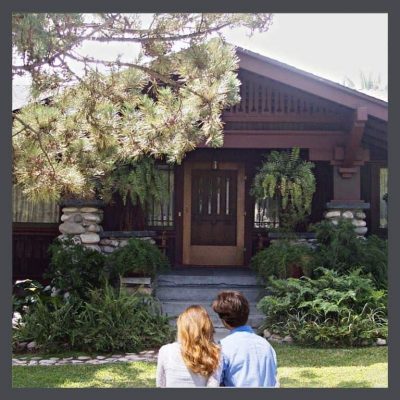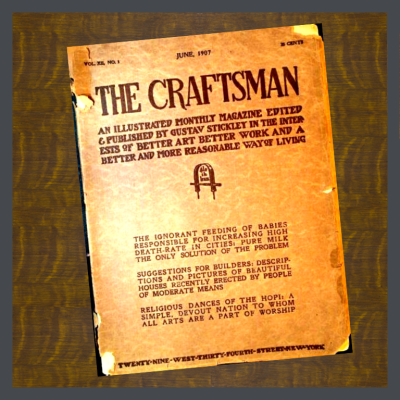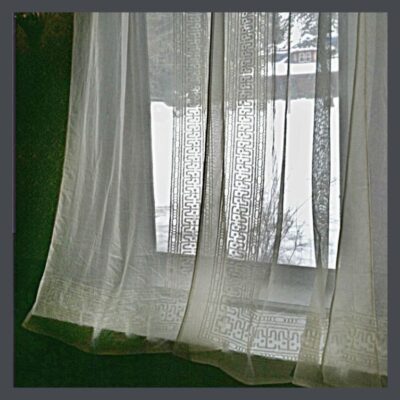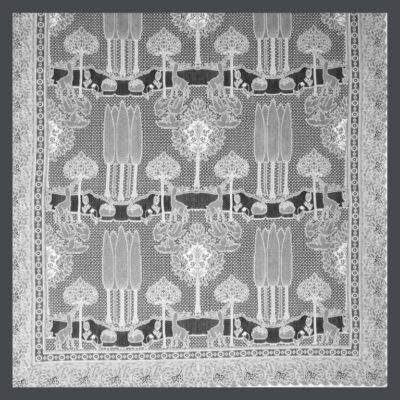 A cautionary bungalow window treatments tale.
A cautionary bungalow window treatments tale.
Once Upon a Time, the Hare House was on the market. I had just finished the bathroom, glad to have a few more weeks in which to enjoy it, kicking myself for not having done it sooner so I would have had a few years.
I spent a day bustling about, getting everything perfect, (including planting a border of annuals, wearing a headlamp, from 10 PM to midnight.) Jane Powell & Linda Svendsen were coming to visit & photograph the house for the book, BUNGALOW: The Ultimate Arts & Crafts Home. During the shoot, I had flung various pieces of furniture, window coverings & décor all around again to comply with Linda’s suggestions. And then, one more exhausted fling for the staging of the open house the next day.
This was, of course, during our neighborhood association’s Home Tour preparation, the grueling last month of pulling together all the loose ends that liked to spring up. Whee-ee-ee!
Soon after the open house we were under contract, but still taking offers. The FOR SALE sign was still outside & the flier box was almost daily restocked with fliers telling the story of Reverend & Grace Hare. This beautiful home, on which I had lavished such care, drew people from all over Los Angeles. Over 100 people had attended the open house, many staying for hours, & Realtors brought long parades of buyers.
Then the packing began. I was beyond exhausted. One afternoon I could do nothing more. I peeled off my sweaty clothes & hit the cool sheets of my brass bed. But was the front door secured? I got up & staggered out to make a quick check on the lock of my beautiful door with its lovely, un-curtained, leaded glass window. A couple, flier in hand, stood at the end of my walkway, peering right at me. I dropped to the floor, hoping that they would believe that I was but a Rubenesque apparition.
ALL ABOUT BUNGALOW WINDOW TREATMENTS
I am writing this as one who prizes old wood windows, loves the various lite patterns of the period & is transported by looking at the world through old, wavy glass. This is about window treatments for old windows that enhances them rather than hiding them.
Well, we already know one re-e-e-eally good reason to cover windows, but there are several others. Different types of window treatments allow you to regulate the amount of light shining into each room, & also to change the light throughout the course of the day. Layered treatments can diffuse light or block it altogether as well as providing some bit of R value.
The textiles of the Arts & Crafts Movement are exquisite. Utilizing natural materials, such as cotton & linen, as well as ornamentation-embroidery, applique & stenciling- inspired by nature, window coverings enhance your interior as well as softening the angular bulk of much Craftsman furniture. Gustav agrees.
WHAT STICKLEY HAD TO SAY
THE FABRICS SUITABLE FOR BUNGALOW WINDOW TREATMENTS
 Stickley brought Arts & Crafts over from England & I’m going to say, evolved it into a truly American aesthetic which suited our more casual lifestyle. Here are some direct quotes from Gustav Stickley’s publication, The Craftsman, regarding textiles in general, with specific references to window coverings.
Stickley brought Arts & Crafts over from England & I’m going to say, evolved it into a truly American aesthetic which suited our more casual lifestyle. Here are some direct quotes from Gustav Stickley’s publication, The Craftsman, regarding textiles in general, with specific references to window coverings.
“At first it was very difficult to find just the right kind of fabric to harmonize with the Craftsman furniture and metal work. It was not so much a question of color, although of course a great deal of the effect depended upon perfect color harmony, as it was a question of the texture and character of the fabric.”
He discarded delicate materials & searched for fabrics- “that possessed sturdiness and durability; that were made of materials that possessed a certain rugged and straightforward character of fiber, weave and texture… not be coarse or crude… “
He decreed the appropriateness of “certain fabrics that harmonize as completely as leather with the general Craftsman scheme. These are mostly woven of flax left in the natural color or given some one of the nature hues. There are also certain roughly- woven, dull-finished silks well as linen, …and for window curtains we use nets and crepes (crinkled texture giving a wrinkled appearance) of the same general character.”
THE COLORS
 Stickley goes on to state, “A material that we use more than almost any other for portieres, (curtain dividing rooms which helped conserve heat) pillows, chair cushions, — indeed in all places were stout wearing quality and a certain pleasant unobtrusiveness are required — is a canvas woven of loosely twisted threads of jute (a very long plant fiber that feels coarse and rough, and is very strong) and flax (a plant, the stem of which is used for making thread, rope, and cloth, and its seeds are used for making linseed oil) and dyed in the piece, — a method which gives an unevenness in color that amounts almost to a two-toned effect because of the way in which the different threads take the dye.
Stickley goes on to state, “A material that we use more than almost any other for portieres, (curtain dividing rooms which helped conserve heat) pillows, chair cushions, — indeed in all places were stout wearing quality and a certain pleasant unobtrusiveness are required — is a canvas woven of loosely twisted threads of jute (a very long plant fiber that feels coarse and rough, and is very strong) and flax (a plant, the stem of which is used for making thread, rope, and cloth, and its seeds are used for making linseed oil) and dyed in the piece, — a method which gives an unevenness in color that amounts almost to a two-toned effect because of the way in which the different threads take the dye.
This unevenness is increased by the roughness of the texture, which is not unlike that of a firmly woven burlap. The colors of the canvas are delightful. For example, there are three tones of wood brown — one almost exactly the color of old weather-beaten oak, another that shows a sunny yellowish tone; and a third that comes close to a dark russet. The greens are the foliage hues, — one dark and brownish like rusty pine needles, another a deep leaf-green; the third an intense green like damp grass in the shade; and a fourth a very gray-green with a bluish tinge like the eucalyptus leaf. Our usual method of decorating this canvas is the application of some bold and simple design in which the solid parts are of linen applique in some contrasting shade and the connecting lines are done in heavy outline stitch or couching; (a technique in which stitches are used to tack down a piece of thread, yarn, etc. to create a unique look and texture. The material being couched doesn’t penetrate the fabric but sits on top of it.) with linen floss (a slightly glossy, 6-strand thread that is a loosely twisted.)
The article about the colors of the Arts & Crafts Movement might help you make some choices too.
We get a further color clues when, speaking of dyed sheepskin, Stickley says, “…we finished in all the subtle shades of brown, biscuit, yellow, gray, green, and fawn…”
THE PREFERRED DESIGN FOR BUNGALOW WINDOW TREATMENTS
“Simplicity is characteristic of all the Craftsman needlework, which is bold and plain to a degree. We use applique in a great many forms, especially for large pieces such as portiere, couch covers, pillows and the larger table covers. For scarfs, window curtains and table furnishings of all kinds we are apt to use the simple darning stitch, as this gives a delightful sparkle to any mass of color.”
“The whole scheme demands a more robust sort of beauty, — something that primarily exists from use and that fulfills every requirement. The charm that it possesses arises from the completeness with which it answers all these demands and the honesty which allows its natural quality to show.”
Pretty much textbook A&C design theory. Not surprising since Stickley wrote the book!
WHAT ABOUT LACE?
 Any Victorian house worth admiring has lace curtains, but lace was used in windows long before Queen Victoria’s reign. They provide privacy as well as admitting light & can be woven into a myriad of patterns from fussy to the more substantial patterns of the Arts & Crafts Movement.
Any Victorian house worth admiring has lace curtains, but lace was used in windows long before Queen Victoria’s reign. They provide privacy as well as admitting light & can be woven into a myriad of patterns from fussy to the more substantial patterns of the Arts & Crafts Movement.
This is the modern interpretation of Gustav Stickley’s version of lace. It certainly follows the lines of his furnishings, being very geometric & extremely simple in design. Made of an open weave, light cotton, I’m thinking that this is what Stickley is speaking of when he mentions the use of net as a material.
Sears catalogues & other advertising materials show only the froofy lace patterns that one would associate with Victoriana. And I have to say that I am not opposed to this type of lace in a bedroom. Not everyone purchased new furniture for the bungalows. My bedroom in the Hare House had a chunky brass bed & Victorian furnuture with simple lines. Reverand Hare had a reputation for helping congregations pay off their church building mortgages in full- quite a celebratory occasion topped off by the burning of the note. So I’m thinking that it was more his nature to make do with the old rather than to buy new for the private areas.
But wait! There’s more!
 For the Hare House, I chose a rather obscure A&C lace. Having been built by a professional man, the leaded glass built-ins, the box beams & the wainscoting seemed to want something formal & I decided early on that I would go in the direction of the more ornate English A&C, rather than the simple, casual American Craftsman style. Truth be told, I have been an Anglophile since my teen years- Twiggy, Carnaby Street, the Beatles- & I had a huge crush on William Morris.
For the Hare House, I chose a rather obscure A&C lace. Having been built by a professional man, the leaded glass built-ins, the box beams & the wainscoting seemed to want something formal & I decided early on that I would go in the direction of the more ornate English A&C, rather than the simple, casual American Craftsman style. Truth be told, I have been an Anglophile since my teen years- Twiggy, Carnaby Street, the Beatles- & I had a huge crush on William Morris.
So, for my living room, I chose C.F.A. Voysey’s The Stag, first produced in Scotland in the early 1900’s. I loved the Hare House. We were soul mates. But of all the bits & pieces that made up the house, I think that I loved these curtains the very most.
SHOW & TELL
I think that rather than continuing on, I’ll send you on to Part 2 which is a list of resources for window coverings-curtains, roller shades, valences, café curtains- & period window hardware. They should all be good choices for you. I also have over 100 window treatment images on my Pinterest page so you can see the work of these very skillful fabric artists & others.
 STAY IN THE BUNGALOW KNOW!!!
STAY IN THE BUNGALOW KNOW!!!
Sign up for our newsletter & receive our FREE E-book, 7 VITAL Things to Do Before You Hire a Contractor.



Lovely
Thank you! Textiles can add a great deal of the A&C aesthetic to a home so I had a wonderful time writing this article.
Love this.
Thank you! It’s a favorite topic of mine & I’ll probably have more to say about it!
Beautiful
Thank you! I love the fact that there were so many talented women who were a vital part of the Movement at the time, creating beautiful textiles.